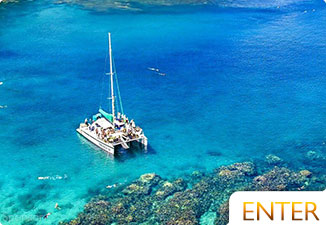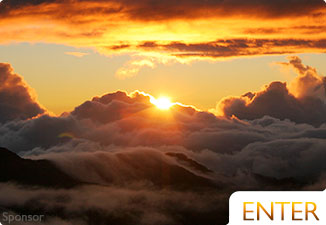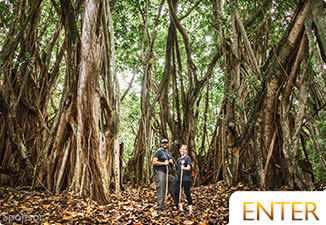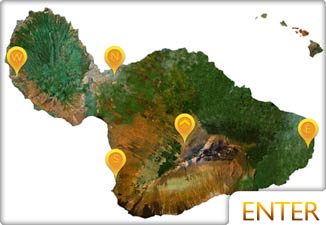Maui > Weather

Maui Weather – Region • Cycle • Month
What’s the weather like on Maui? The island of Maui is made up of numerous different sub-climates. Depending on where you are, Maui weather can act in a multitude of ways. For the most part, each area has a general weather pattern.
Below we’ve listed the weather that each part of the island typically holds.
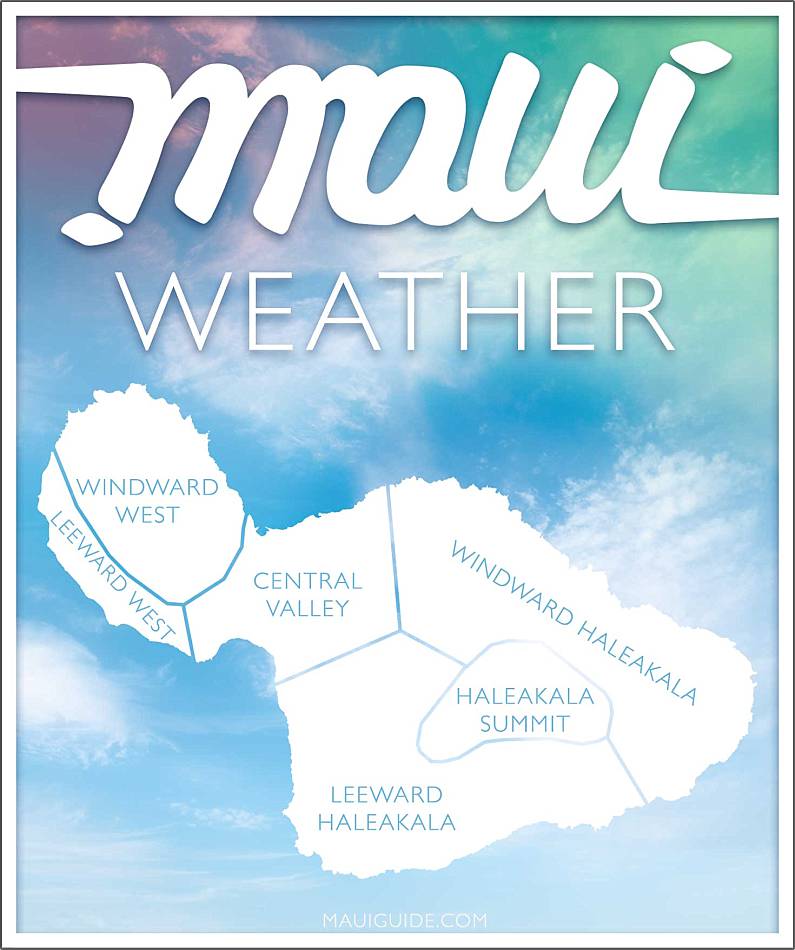
Maui Weather by Region
Because of the warm ocean airflow, the West Maui Mountains get a lot of rain. ʻIao Valley rarely sees a day without some kind of precipitation. Wailuku Town is located over here as well as some of Upper West Maui like Honolua Bay. All of these areas are lush and green due to the near-constant wet weather. If it is raining, check out things to do when it rains in Maui.
Leeward West
Similar to the South of Maui, most of the leeward side of West Maui is located on lower ground near the coast. This area is warmer, sunnier, and drier than the rest of the island. We do notice that Lahaina town tends to get a very minor amount of additional rain than the Kihei area in comparison (though Lahaina is very dry too.) The further up you go in West Maui, the wetter it will get. Kapalua is known to have a band of rain clouds regularly dowsing it. You’ll find the landscape becomes more diverse and lush further north. Due to changes in the layout of the land via construction, and the move away from the traditional ahupua’a system, the west side of Maui is subject to wild brush fires in the summer from the dry heat.
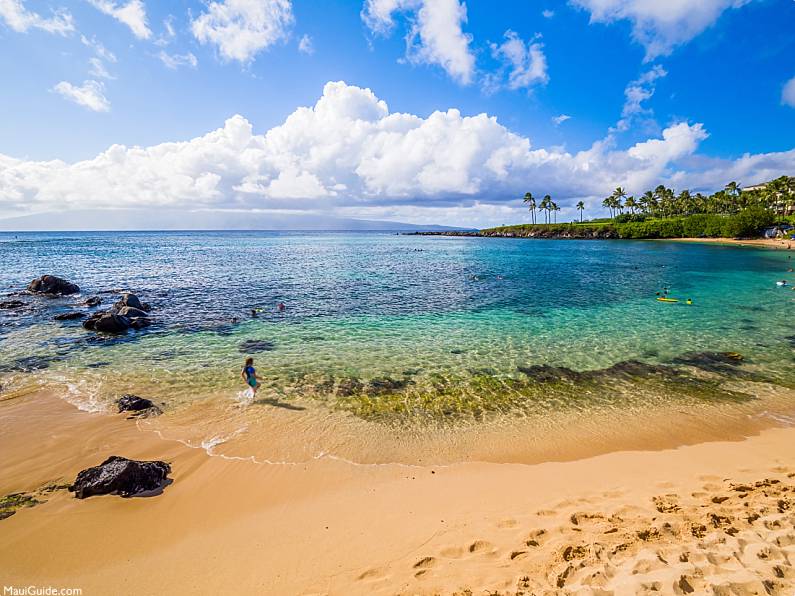
Central Valley
The central valley of Maui encompasses Maalaea, part of North Kihei, Wailuku, and Kahului. This area is dry and windy. Maui is made up of two huge mountainous regions with a valley between them. The valley is home to mostly sugar cane fields and is usually sunny between the afternoon clouds that show up on each mountain.
Leeward Haleakala
Leeward Haleakala consists of South Maui and most of Up Country Maui. South Maui is home to Kihei, Wailea, and Makena. These areas get the least amount of rain on the island. This isn’t to say that it doesn’t rain. Some parts of Makena and Wailea get more scattered clouds and light rain, like Kihei’s Maui Meadows, which gets more rain and is cooler than the lower parts of Kihei. Generally, the higher in elevation, the cooler it gets, and Maui’s elevation changes drastically within miles of itself. Certain portions of Makena have a constant stream of clouds flowing in a strip from Kahoolawe to the crater summit. Southern parts of Big Beach (Makena Beach) are covered by this cloud formation frequently. Upcountry Maui is much cooler and wetter than South Maui. The elevation is considerably higher here, which is conducive to more rain and colder air. The ancient Hawaiians who lived on this side of Maui would travel up the slopes to the upcountry during the summer and live in South Maui for the rest of the year.
25 Things To Do On Maui
Windward Haleakala
The windward side of Haleakala is home to Hana and everything on the Road to Hana. This area is the wettest because of Haleakala’s tall slopes. Trade winds are responsible for blowing in moist air from the ocean, which Haleakala deflects up its slopes. Once the saturated air cools with altitude, it rains. This is the same for the windward side of the West Maui Mountains. The leeward sides of both these mountainous regions are blocked from the rain and get very little precipitation. The Windward side of Haleakala rains over 3/4 of the year. When you drive the Road to Hana, you’ll most likely get wet at one point or another.
Haleakala Summit
The Summit of Haleakala is a completely different world. With the look and feel of our moon’s landscape, the crater of Haleakala is vast and high. Towering to over 10,000 ft, Haleakala Crater regularly reaches below zero in temperature and has on occasion even snowed. Dress warmly when visiting this area, and remember to do this especially when you go on a helicopter tour of the crater. If you’re planning on catching the sunrise or sunset at the summit, keep in mind that it is cloudy more often than not. If it’s clear, you’ll have a view like no other. It feels as though you’re on top of the world, and in reality, you are!
Maui Weather Cycle

From the crater at Haleakala’s summit, you can watch Maui weather being made. On a typically warm day, trade winds carry moisture-laden air up the northeast slopes of Haleakala. As the moisture rises, it cools and condenses into the cloud layer that frequently rings the mountain.
Rising warm air often pushes the clouds up through Ko’olau Gap and Kaupo Gap. As the evening air cools, the clouds drain out of the valley and the cycle begins again.
Haleakala influences weather all around the volcano. Average annual rainfall varies from about 400 inches (10.16m) in the high-elevation rain forest above Hana to 10 inches (25 cm) in Kihei, only about 15 minutes apart. Because temperatures drop about 3.2F (1.3C) every 1,000 feet (305m), the summit of Haleakala is roughly 32F (13C) cooler than the beaches.
Average Maui Weather By The Month
December, January, and February
These months have the lowest temperatures of the year. Keep in mind that it’s still plenty warm in many areas. With regular showers, these winter months are home to the wettest Maui weather of the year. In January, tradewinds only blow half as much as they do in the summer. Throughout the winter, generally from November to March, large North Swells create big surf on our North and Northwest-facing beaches. The ocean temp in Maui is approximately 75 F, and the air temperature averages between 65-80 degrees F depending on which area you’re in, and closer to 64-79 degrees F in Hana.
Hawaii weather in March, April, and May
We find this time of year to be much like a mix between September, October, and November. Some days are warm and above 80, while others are chilly in the low 70s. We get plenty of rain still, depending on when you’re on-island. Whales are still around a bit, though leaving the islands. Again, keep in mind that the weather is different across the island depending on your region. Any time of year it can be dumping rain in Haiku and gorgeous on the beaches of Kihei. Hurricane-windy in Paia and calm in Lahaina. We have almost every micro-climate, so if you’re seeing an 85% chance of rain, consider driving for 10 minutes in any direction.
June, July
You’ll find Maui summers to be the most crowded with visitors because it’s hot and dry. By now Hana has caught up and is warmer at times than the rest of the island. June is extremely dry for Maui and trades blow almost always. With most of Maui at 69-87 degrees F, you’ll find it sunny and warm almost everywhere. One of the major pluses of the constant trade winds is their tendency to cool things down. Be wary of the sun! With the wind comes a disillusionment of how hot the sun really is on your skin. Wear sunblock on exposed areas at all times. You can be out for just 5 minutes and turn into a lobster.
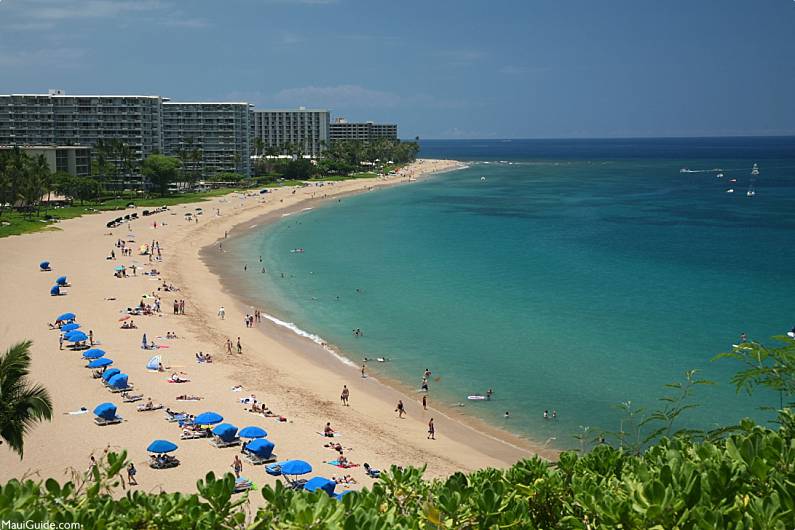
August, September
These months on Maui are the pinnacles of summer heat. This is often the most humid of the summer months. Maui ocean water temperatures are from 79 to 80 degrees Fahrenheit. Maui air temperatures are from 70-80 degrees F depending on the area. Hana begins to get cooler and drops to between 70-84 degrees F during these last summer months. The Pacific Ocean sees Tropical Hurricanes during these months, but they are rarely close to the Hawaiian Islands.
October, November
are transitional months on Maui from summer to winter. Scattered clouds begin to form and patchy rain starts to fall. With a few degrees drop in temperature and an occasional storm, Maui’s winter begins to step in. Average temperatures are from 68-88 degrees F and 68-83 F in Hana. Ocean temperatures are between 77 F and 79 F in October and November. Keep in mind that the winter in Maui really isn’t a traditional winter. The differences between seasons in Maui are not all that significant relatively. Weather differences on Maui are more strongly noticed by location on the island than by what time of year it is.

